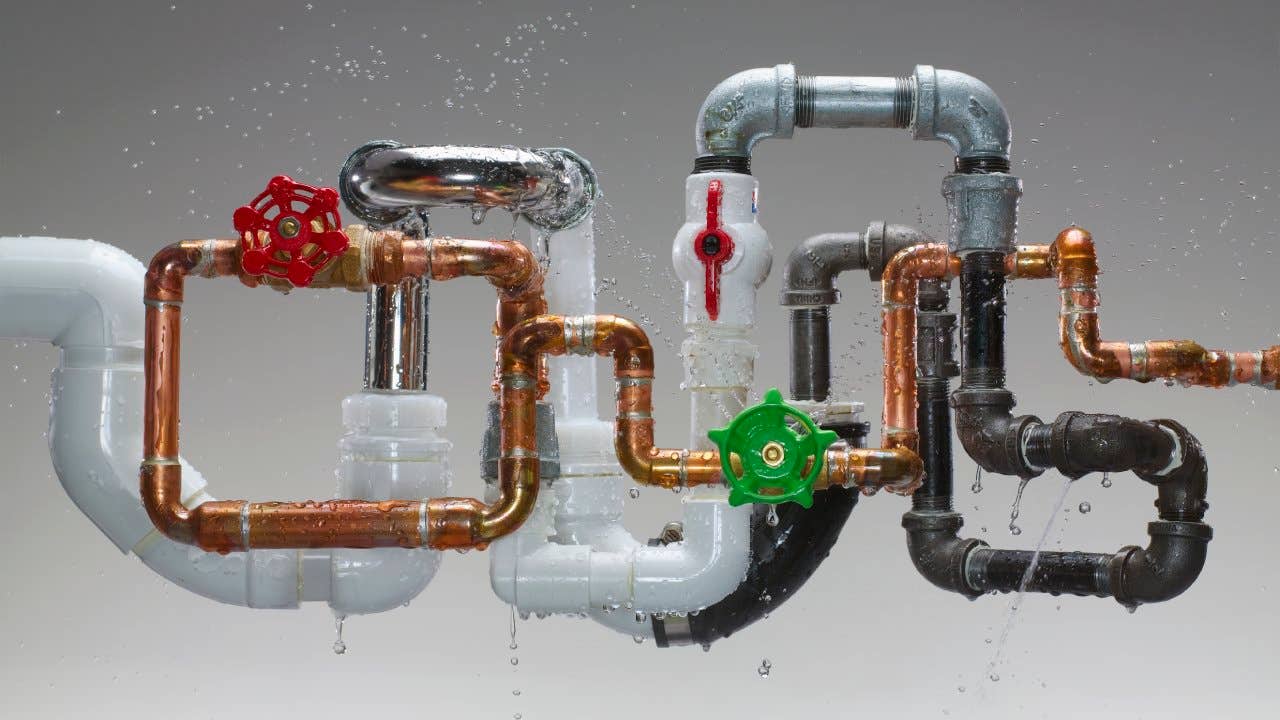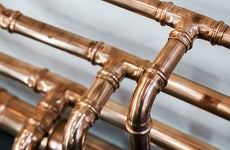Which plumbing pipes cost the most money?

The Bankrate promise
At Bankrate we strive to help you make smarter financial decisions. While we adhere to strict , this post may contain references to products from our partners. Here's an explanation for .
We tend to take for granted the plumbing pipes in our homes (until and unless they break, of course). But if you’re building, adding onto or renovating a home — especially an older one — the type of pipe is something you may well have to consider.
Not all pipes are created equally, and they certainly don’t have the same price tag. And that, of course, begs the question: how much do pipes cost? The price of pipes ranges from about $0.40 to $10.00 per linear foot, depending on the type of pipe material. Metal pipes cost more than plastic ones as a general rule.
The cost to replace plumbing will depend on which type of pipe material you choose and the rate for installation in your area. Some pipes are easier to install than others. Bear in mind that installation may require the removal and replacement of any drywall or flooring, too.
Still, the bulk of your costs are likely to come from the pipes themselves. Your primary choices are:
- Copper
- PEX
- CPVC
- Galvanized Steel
- Cast Iron
- ABS
Before we look at the pros and cons of the different types, let’s talk about the costs to install them.
What do pipes cost to install?
The right pipe for your project should consider the durability and longevity you require, plus the cost of materials and labor. Less flexible and heavier pipes can be more expensive to install because they require expertise and are more complex to work with, but they might last longer.
When you’re budgeting for your overall plumbing pipe cost, be ready to pay $1-2 per linear foot for labor. Installing metal pipes generally costs more than plastic.
| Material | Material Cost Per Linear Foot | Material and Labor Cost Per Linear Foot | Common Uses | What You Should Know |
|---|---|---|---|---|
| Copper | $2–$8 | $3-$10 | High-end plumbing projects, all water temperatures | The gold standard in plumbing pipes, can last up to 100 years |
| PEX | $0.40–$2 | $1.50-$3 | Any, including in-floor heating | Leak resistant, designed to last long, affordable |
| CPVC | $0.50–$1 | $1.40-$4 | Most water temperatures, budget projects | Can last 50–70 years, needs to be fitted precisely to avoid leaks |
| Galvanized Steel | ~$8 | $9-$10 | Older homes, high-pressure plumbing | Shorter lifespan (~40 years) |
| Cast Iron | $2–$10 | $3-$12 | Sewage, drainage | Likely to corrode |
| ABS | $1–$10 | $3–$12 (for indoor plumbing costs, higher for sewage projects) | Sewage, drainage, venting | Dangerous for drinking water, degrades in sunlight |
Copper pipe
What it is: Copper is sort of the gold standard in pipes. Known for its durability, it can last as long as 100 years. Copper pipes are naturally resistant to bacteria and are less likely to break down if exposed to UV rays. As a result, the cost of copper pipe per foot exceeds a lot of other piping options. Many brass pipes, which are not as common, are also composed primarily of copper with slightly less durability.
Cost: $2–8 per linear foot
Pros
- Stands the test of time
- Handles heat well
- May increase home value
Cons
- More expensive than other types of pipes
- May be subject to theft if materials are left unsupervised
- Like any metal, can be subject to corrosion
CPVC pipe
What it is: Chlorinated polyvinyl chloride (CPVC) piping is one of the oldest types of modern pipes, in use since at least the 1960s. It’s the cousin of PVC piping, made of very similar material but altered with chlorine to make it better able to withstand a wider range of temperatures, especially on the high end. This type of plastic pipe has thick walls that can be used for both cold and hot water lines (PVC only works well for unheated water), and it’s extremely well-priced. Unfortunately, there are some drawbacks in exchange for that low plumbing pipe cost. CPVC can be more likely to leak, especially if not fitted precisely at the time of installation. It also has a shorter lifespan — about 50-70 years.
Cost: $0.50–$1 per linear foot
Pros
- Very affordable
- Time-tested
- Can be used for a variety of projects
Cons
- Requires joints to make certain angles
- Doesn’t last as long as other types of pipes
PEX pipe
What it is: Cross-linked polyethylene pipes (PEX) are highly flexible, both literally and figuratively. They can be used with other types of pipes, making them ideal for repairs or complex system replacements. Developed in the 1990s, they are a relatively new type of piping material that is quite durable — theoretically about on a par with copper, though the exact lifespan is yet unknown — and unlikely to leak. In other words, if you’re looking for something with a long lifespan without the high cost of copper pipe per foot, PEX is a solid option.
Cost: $0.40–$2 per linear foot
Pros
- Less expensive than copper
- Good for in-floor heating
- May last for 80-100 years
Cons
- Not always compatible with every existing system
- Require specialized tools to install
- May burst with age
Galvanized steel pipe
What it is: Galvanized steel pipes, sometimes called just galvanized pipes, are most likely to be found in homes that are 40 years old or more. Made from steel dipped in a zinc coating, they used to be quite popular — a safer alternative to lead, it was once thought. While their zinc coating survives, the pipes can be quite durable; however, once their coating corrodes over time, the exposed steel is very likely to rust and become unstable. Add the fact that the price of pipes made from galvanized steel is fairly high and it’s no surprise these aren’t commonly used anymore.
Cost: About $8 per linear foot
Pros
- Durable while the zinc coating is strong
- Can handle high pressure situations
- Lifespan is only about 40 years
Cons
- Can lead to rust and particles in your water
- Expensive to replace
Cast iron pipe
What it is: Cast iron pipes were the standard until about the 1960s, when steel and PCVC began to take over. Their walls are thicker than that of steel pipes, and they may also sport a protective lining. Unfortunately, while strong, cast iron pipes are not flexible and are susceptible to rust. While these pipes may still be an optimal choice for sewage and drainage, nowadays they are unlikely to be recommended for a residence because they are heavier and more likely to become corroded than the more malleable materials that are now available.
Cost: $2–10 per linear foot
Pros
- Thick pipe lining
- May be retrofitted with newer pipes for repairs
- Can be ideal for commercial settings/use
Cons
- Heavy and hard to cut
- Highly subject to rust, corrosion
- Little to no flexibility
ABS Piping
What it is: Pipes made from acrylonitrile butadiene styrene — or ABS, for short — are known for their ability to withstand extreme hot or cold temperatures and pressure. Usually colored black, these plastic pipes work best for drainage, sewage and ventilation. They shouldn’t connect to your house’s drinking water supply, because they contain Bisphenol A (BPA), a chemical that enhances their durability, but can cause cancer when consumed. ABS pipes are typically installed underground to carry waste away from homes.
Cost: $1–$10
Pros
- Affordable
- Durable enough to withstand cold and defy leaks underground
- Single-step joining process
Cons
- Limited use—not for drinking water lines
- Degrades in direct sunlight
Bottom line on types of plumbing pipes
Nothing lasts forever, including your home’s plumbing system. Whether you’re ready to replace outdated pipes with money from a home equity loan or you’re shopping your options because your homeowners insurance will pay to repair a burst pipe, you won’t be left wanting for choices. Beyond the price of pipes, you should also consider the use case, labor cost and lifespan.
It’s widely recommended that, because of corrosion issues, homeowners replace galvanized steel and cast iron pipes with either traditional copper (which costs the most, but also comes with a very long lifespan) or one of the newer plastic options (PEX and CPVC). Of those two, CPVC is cheaper and offers lots of bang for the plumbing buck, but PEX is widely praised for offering copper’s durability at close-to-CPVC prices — plus its own characteristic flexibility.
Related Articles



